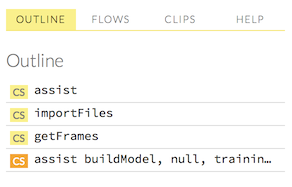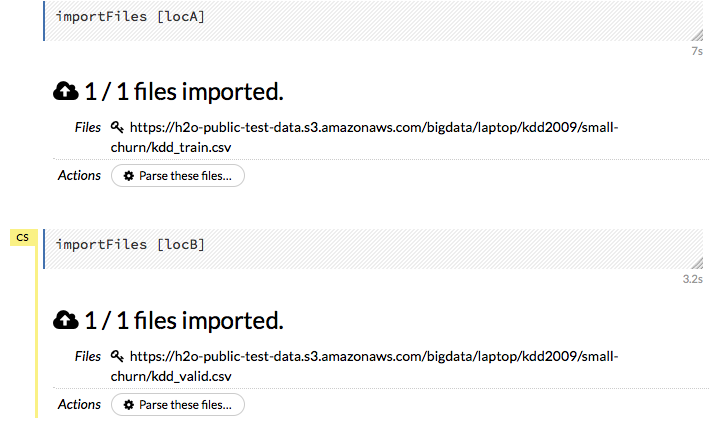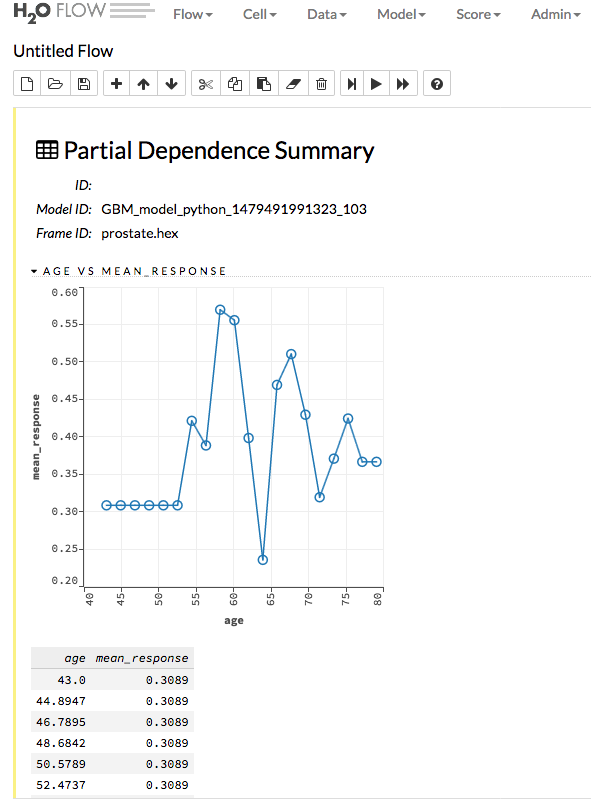Using Flow - H2O’s Web UI¶
About¶
H2O Flow is an open-source user interface for H2O. It is a web-based interactive environment that allows you to combine code execution, text, mathematics, plots, and rich media in a single document.
With H2O Flow, you can capture, rerun, annotate, present, and share your workflow. H2O Flow allows you to use H2O interactively to import files, build models, and iteratively improve them. Based on your models, you can make predictions and add rich text to create vignettes of your work - all within Flow’s browser-based environment.
Flow’s hybrid user interface seamlessly blends command-line computing with a modern graphical user interface. However, rather than displaying output as plain text, Flow provides a point-and-click user interface for every H2O operation. It allows you to access any H2O object in the form of well-organized tabular data.
H2O Flow sends commands to H2O as a sequence of executable cells. The cells can be modified, rearranged, or saved to a library. Each cell contains an input field that allows you to enter commands, define functions, call other functions, and access other cells or objects on the page. When you execute the cell, the output is a graphical object, which can be inspected to view additional details.
While H2O Flow supports REST API, R scripts, and CoffeeScript, no programming experience is required to run H2O Flow. You can click your way through any H2O operation without ever writing a single line of code. You can even disable the input cells to run H2O Flow using only the GUI. H2O Flow is designed to guide you every step of the way, by providing input prompts, interactive help, and example flows.
Download Flow¶
- First Download H2O. This will download a zip file in your Downloads folder that contains everything you need to get started. Alternatively, you can run the following from your command line, replacing “{version}” with the appropriate version (for example, 3.8.2.5)
curl -o h2o.zip http://download.h2o.ai/versions/h2o-{version}.zip
- Next in your terminal, enter the following command lines one at a time:
(The first line changes into your Downloads folder, the second line unzips your zipfile, the third line changes into your h2o-3.8.2.3 folder, and the fourth line runs your jar file.):
cd ~/Downloads unzip h2o-3.8.2.3.zip cd h2o-3.8.2.3 java -jar h2o.jar
- Finally, to start Flow point your browser to http://localhost:54321.
Launch Flow¶
The next time you want to launch Flow, change into the directory that contains your H2O package and run the JAR file from the command line.
Note: If your H2O package is not in the Downloads folder, replace the following path ~/Downloads/h2o-{version} with the correct path to your h2o-{version} package):
cd ~/Downloads/h2o-{version}
java -jar h2o.jar
How to Use the Interface¶
This guide walks through using Flow, H2O’s web UI, for machine learning projects.
Accessing Help¶
Within the Flow web page, pressing the h key will open a list of helpful shortcuts on your screen:

To close this window, click the X in the upper-right corner or click the Close button in the lower-right corner. You can also click behind the window to close it. You can also access this list of shortcuts by clicking the Help menu and selecting Keyboard Shortcuts.
For additional help, click Help > Assist Me or click the Assist Me! button in the row of buttons below the menus.

You can also type assist in a blank cell and press Ctrl+Enter. A
list of common tasks displays to help you find the correct command.
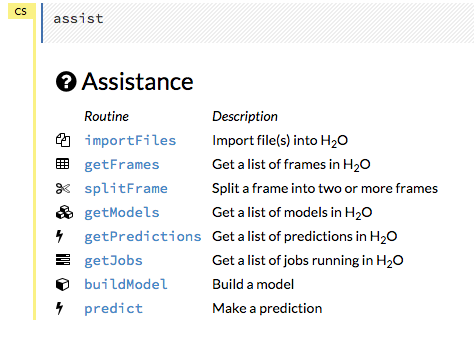
There are multiple resources to help you get started with Flow in the Help sidebar.
Note: To hide the sidebar, click the >> button above it
To display the sidebar if it is hidden, click the >> button
To access this documentation, select the Flow Web UI... link below the General heading in the Help sidebar.
Viewing Example Flows¶
You can explore the pre-configured flows available in H2O Flow for a demonstration of how to create a flow. To view the example flows:
Click the view example Flows link below the Quickstart Videos button in the Help sidebar
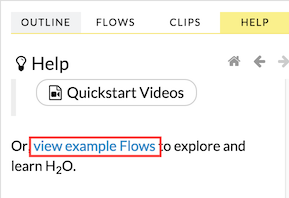
–OR–
- Click the Browse installed packs... link in the Packs subsection of the Help sidebar. Click the examples folder and select the example flow from the list.

If you have a flow currently open, a confirmation window appears asking if the current notebook should be replaced. To load the example flow, click the Load Notebook button.
Viewing REST API Documentation¶
To view the REST API documentation, click the Help tab in the sidebar and then select the type of REST API documentation (Routes or Schemas).

Before getting started with H2O Flow, make sure you understand the different cell modes. (Refer to Understanding Cell Modes.) Certain actions can only be performed when the cell is in a specific mode.
Using Flows¶
You can use and modify flows in a variety of ways:
- Clips allow you to save single cells
- Outlines display summaries of your workflow
- Flows can be saved, duplicated, loaded, or downloaded
Using Clips¶
Clips enable you to save cells containing your workflow for later reuse.
To save a cell as a clip, click the paperclip icon to the right of the
cell (highlighted in the red box in the following screenshot).

To use a clip in a workflow, click the “Clips” tab in the sidebar on the right.

All saved clips, including the default system clips (such as assist,
importFiles, and predict), are listed. Clips you have created
are listed under the “My Clips” heading. To select a clip to insert,
click the circular button to the left of the clip name. To delete a
clip, click the trashcan icon to right of the clip name.
NOTE: The default clips listed under “System” cannot be deleted.
Deleted clips are stored in the trash. To permanently delete all clips in the trash, click the Empty Trash button.
NOTE: Saved data, including flows and clips, are persistent as long as the same IP address is used for the cluster. If a new IP is used, previously saved flows and clips are not available.
Viewing Outlines¶
The Outline tab in the sidebar displays a brief summary of the cells currently used in your flow; essentially, a command history.
- To jump to a specific cell, click the cell description.
- To delete a cell, select it and press the X key on your keyboard.
Saving Flows¶
You can save your flow for later reuse. To save your flow as a notebook, click the “Save” button (the first button in the row of buttons below the flow name), or click the drop-down “Flow” menu and select “Save Flow.” To enter a custom name for the flow, click the default flow name (“Untitled Flow”) and type the desired flow name. A pencil icon indicates where to enter the desired name.

To confirm the name, click the checkmark to the right of the name field.

To reuse a saved flow, click the “Flows” tab in the sidebar, then click the flow name. To delete a saved flow, click the trashcan icon to the right of the flow name.
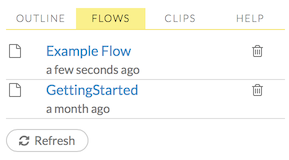
Finding Saved Flows on Your Disk¶
By default, flows are saved to the h2oflows directory underneath
your home directory. The directory where flows are saved is printed to
stdout:
03-20 14:54:20.945 172.16.2.39:54323 95667 main INFO: Flow dir: '/Users/[YOUR_USER_NAME]/h2oflows'
To back up saved flows, copy this directory to your preferred backup location.
To specify a different location for saved flows, use the command-line
argument -flow_dir when launching H2O:
java -jar h2o.jar -flow_dir /[ENTER_PATH_TO_FLOW_DIRECTORY_HERE]
If the directory that you enter in place of [ENTER_PATH_TO_FLOW_DIRECTORY_HERE] does not exist, it will be created
the first time you save a flow.
Saving Flows on a Hadoop Cluster¶
If you are running H2O Flow on a Hadoop cluster, H2O will try to find
the HDFS home directory to use as the default directory for flows. If
the HDFS home directory is not found, flows cannot be saved unless a
directory is specified while launching using -flow_dir:
hadoop jar h2odriver.jar -nodes 1 -mapperXmx 6g -output hdfsOutputDirName -flow_dir hdfs://[HOST]:[PORT_NUMBER]/[PATH_TO_DIRECTORY_HERE]
The location specified in -flow_dir may be either an hdfs or regular
filesystem directory. If the directory does not exist, it will be
created the first time you save a flow.
Copying Flows¶
To create a copy of the current flow, select the Flow menu, then
click Make a Copy. The name of the current flow changes to
Copy of <FlowName> (where <FlowName> is the name of the flow).
You can save the duplicated flow using this name by clicking Flow >
Save Flow, or rename it before saving. (Refer to Saving Flows.)
Downloading Flows¶
After saving a flow as a notebook, click the Flow menu, then select
Download this Flow. A new window opens and the saved flow is
downloaded to the default downloads folder on your computer. The file is
exported as <filename>.flow, where <filename> is the name
specified when the flow was saved.
Caution: You must have an active internet connection to download flows.
Loading Flows¶
To load a saved flow, click the Flows tab in the sidebar at the right. In the pop-up confirmation window that appears, select Load Notebook, or click Cancel to return to the current flow.

After clicking Load Notebook, the saved flow is loaded.
To load an exported flow, click the Flow menu and select Open Flow.... In the pop-up window that appears, click the Choose File button and select the exported flow, then click the Open button.

Notes:
- Only exported flows using the default .flow filetype are supported. Other filetypes will not open.
- If the current notebook has the same name as the selected file, a pop-up confirmation appears to confirm that the current notebook should be overwritten.
Understanding Cell Modes¶
There are two modes for cells: Edit and Command.
Using Edit Mode¶
In edit mode, the cell is yellow with a blinking bar to indicate where text can be entered and there is an orange flag to the left of the cell.

Using Command Mode¶
In command mode, the flag is yellow. The flag also indicates the cell’s format:
- MD: Markdown
Note: Markdown formatting is not applied until you run the cell by:
- clicking the Run button
or
- pressing Ctrl+Enter

- CS: Code (default)
- RAW: Raw format (for code comments)
- H[1-6]: Heading level (where 1 is a first-level heading)
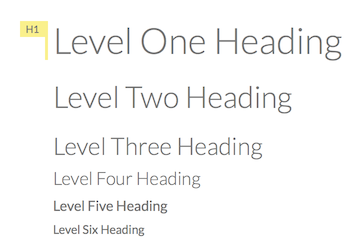
NOTE: If there is an error in the cell, the flag is red.

If the cell is executing commands, the flag is teal. The flag returns to yellow when the task is complete.
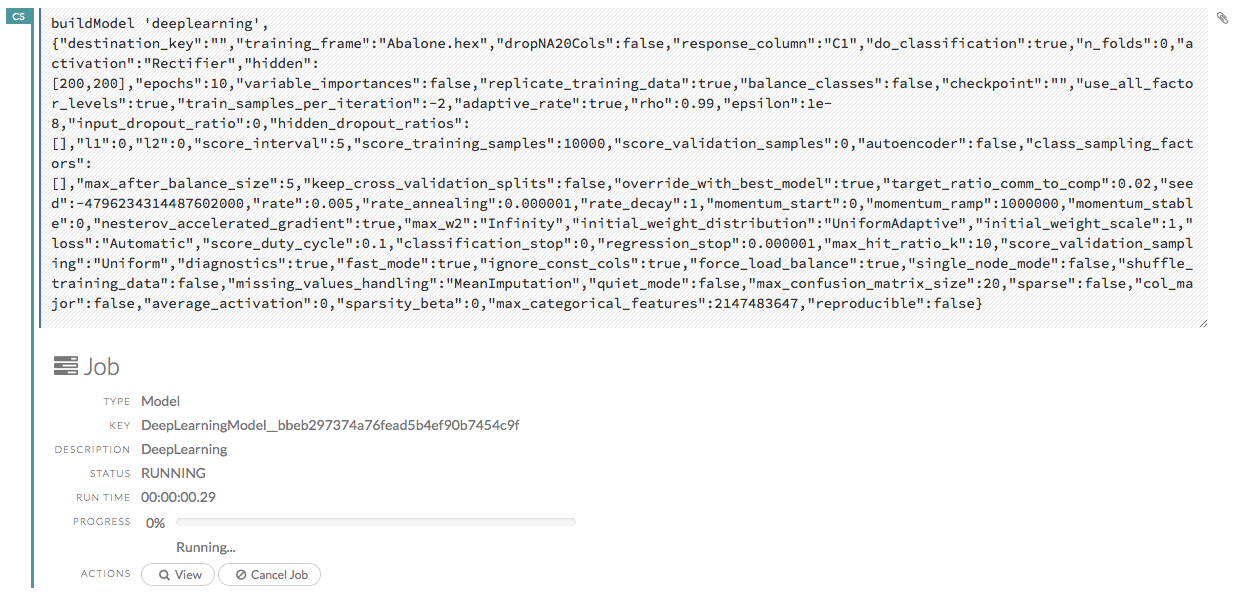
Changing Cell Formats¶
To change the cell’s format (for example, from code to Markdown), make sure you are in command (not edit) mode and that the cell you want to change is selected. The easiest way to do this is to click on the flag to the left of the cell. Enter the keyboard shortcut for the format you want to use. The flag’s text changes to display the current format.
| Cell Mode | Keyboard Shortcut |
|---|---|
| Code | y |
| Markdown | m |
| Raw text | r |
| Heading 1 | 1 |
| Heading 2 | 2 |
| Heading 3 | 3 |
| Heading 4 | 4 |
| Heading 5 | 5 |
| Heading 6 | 6 |
Running Cells¶
The series of buttons at the top of the page below the menus run cells in a flow.

To run all cells in the flow, click the Flow menu, then click Run All Cells.
To run the current cell and all subsequent cells, click the Flow menu, then click Run All Cells Below.
To run an individual cell in a flow, confirm the cell is in Edit Mode (refer to Using Edit Mode), then:
- press Ctrl+Enter
or
- click the Run button

Running Flows¶
When you run the flow, a progress bar indicates the current status of the flow. You can cancel the currently running flow by clicking the Stop button in the progress bar.

When the flow is complete, a message displays in the upper right.


Note: If there is an error in the flow, H2O Flow stops at the cell that contains the error.
Using Keyboard Shortcuts¶
Here are some important keyboard shortcuts to remember:
- Click a cell and press Enter to enter edit mode, which allows you to change the contents of a cell.
- To exit edit mode, press Esc.
- To execute the contents of a cell, press the Ctrl and Enter buttons at the same time.
The following commands must be entered in Command Mode. (Refer to Using Command Mode.)
- To add a new cell above the current cell, press a.
- To add a new cell below the current cell, press b.
- To delete the current cell, press the d key twice. (dd).
You can view these shortcuts by clicking Help > Keyboard Shortcuts or by clicking the Help tab in the sidebar.
Using Variables in Cells¶
Variables can be used to store information such as download locations. To use a variable in Flow:
Define the variable in a code cell (for example,
locA = "https://h2o-public-test-data.s3.amazonaws.com/bigdata/laptop/kdd2009/small-churn/kdd_train.csv").
Run the cell. H2O validates the variable.
- Use the variable in another code cell (for example,
importFiles [locA]).
To further simplify your workflow, you can save the cells containing the variables and definitions as clips. (Refer to Using Clips.)
Using Flow Buttons¶
There are also a series of buttons at the top of the page below the flow name that allow you to save the current flow, add a new cell, move cells up or down, run the current cell, and cut, copy, or paste the current cell. If you hover over the button, a description of the button’s function displays.
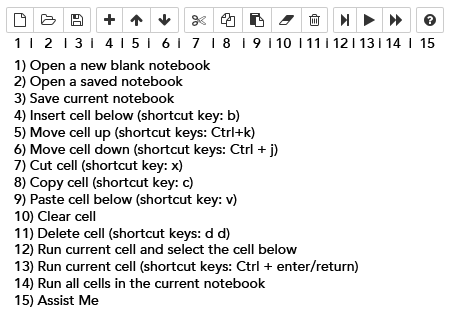

Note: To disable the code input and use H2O Flow strictly as a GUI, click the Cell menu, then Toggle Cell Input.
Now that you are familiar with the cell modes, let’s import some data.
Importing Data¶
If you don’t have any data of your own to work with, you can find some example datasets at http://data.h2o.ai.
Importing Files¶
There are multiple ways to import data in H2O flow:
- Click the Assist Me! button in the row of buttons below the
menus, then click the importFiles link. Enter the file path in
the auto-completing Search entry field and press Enter.
Select the file from the search results and confirm it by clicking
the Add All link.
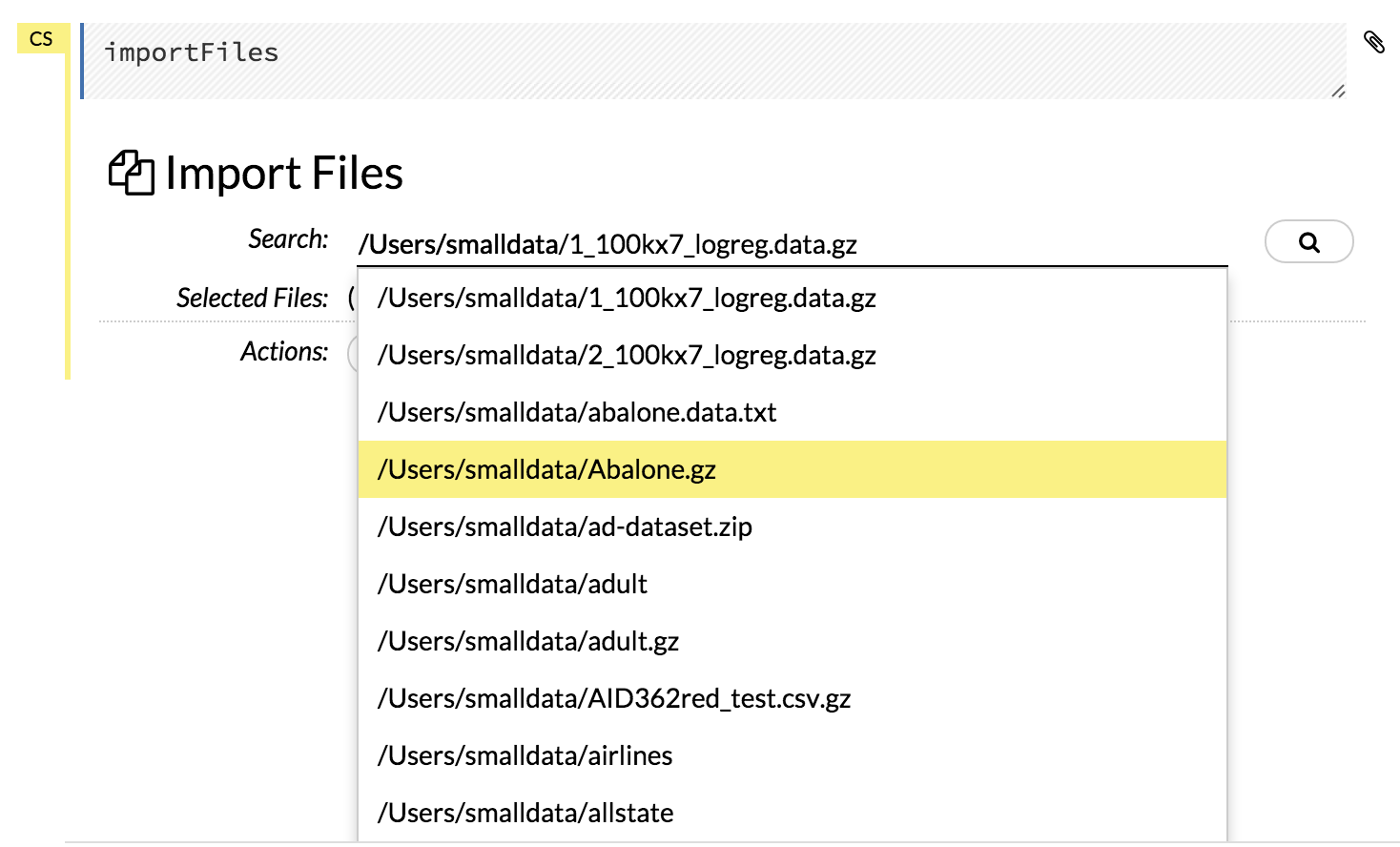
- In a blank cell, select the CS format, then enter
importFiles ["path/filename.format"](wherepath/filename.formatrepresents the complete file path to the file, including the full file name. The file path can be a local file path or a website address. Note: For S3 file locations, use the formatimportFiles [ "s3n:/path/to/bucket/file/file.tab.gz" ]
Note: For an example of how to import a single file or a directory in R, refer to the following example.
After selecting the file to import, the file path displays in the
“Search Results” section. To import a single file, click the plus sign
next to the file. To import all files in the search results, click the
Add all link. The files selected for import display in the “Selected
Files” section. 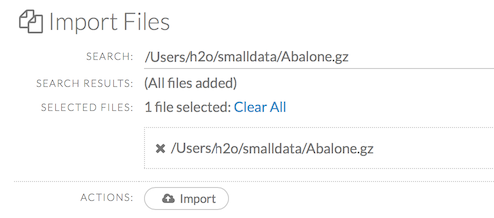
Note: If the file is compressed, it will only be read using a single thread. For best performance, we recommend uncompressing the file before importing, as this will allow use of the faster multithreaded distributed parallel reader during import. Please note that .zip files containing multiple files are not currently supported.
- To import the selected file(s), click the Import button.
- To remove all files from the “Selected Files” list, click the Clear All link.
- To remove a specific file, click the X next to the file path.
After you click the Import button, the raw code for the current job displays. A summary displays the results of the file import, including the number of imported files and their Network File System (nfs) locations.
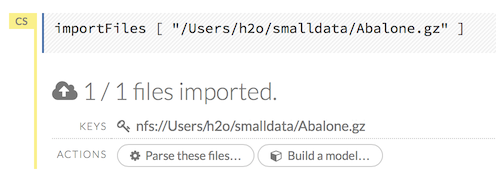
Uploading Data¶
To upload a local file, click the Data menu and select Upload File.... Click the Choose File button, select the file, click the Choose button, then click the Upload button.

When the file has uploaded successfully, a message displays in the upper right and the Setup Parse cell displays.

Ok, now that your data is available in H2O Flow, let’s move on to the next step: parsing. Click the Parse these files button to continue.
Parsing Data¶
After you have imported your data, parse the data.

The read-only Sources field shows the file path for the imported data selected for parsing. The ID contains the auto-generated name for the parsed data (by default, the file name of the imported file uses .hex as the file extension). Use the default name or enter a custom name in this field.
- Select the parser type (if necessary) from the drop-down Parser list. For most data parsing, H2O automatically recognizes the data type, so the default settings typically do not need to be changed. The following options are available:
- Auto
- ARFF
- XLS
- XLSX
- CSV
- SVMLight
Note: For SVMLight data, the column indices must be >= 1 and the columns must be in ascending order.
- If a separator or delimiter is used, select it from the Separator list.
- Select a column header option, if applicable:
- Auto: Automatically detect header types.
- First row contains column names: Specify heading as column names.
- First row contains data: Specify heading as data. This option is selected by default.
- Select any necessary additional options:
- Enable single quotes as a field quotation character: Treat single quote marks (also known as apostrophes) in the data as a character, rather than an enum. This option is not selected by default.
- Delete on done: Check this checkbox to delete the imported data after parsing. This option is selected by default.
A preview of the data displays in the “Edit Column Names and Types” section. To change or add a column name, edit or enter the text in the column’s entry field. In the screenshot below, the entry field for column 16 is highlighted in red.
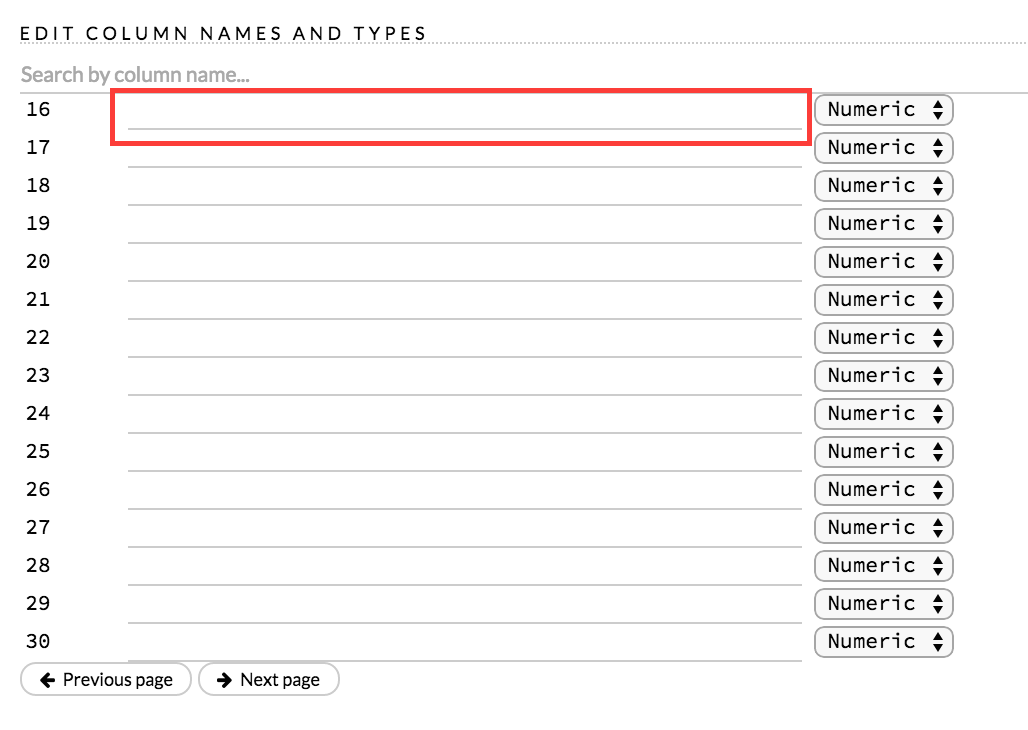
To change the column type, select the drop-down list to the right of the column name entry field and select the data type. The options are:
- Unknown
- Numeric
- Enum
- Time
- UUID
- String
- Invalid
You can search for a column by entering it in the Search by column name... entry field above the first column name entry field. As you type, H2O displays the columns that match the specified search terms.
Note: Only custom column names are searchable. Default column names cannot be searched.
To navigate the data preview, click the <- Previous page or -> Next page buttons.

After making your selections, click the Parse button. The code for the current job displays.

Since we’ve submitted a couple of jobs (data import & parse) to H2O now, let’s take a moment to learn more about jobs in H2O.
Viewing Jobs¶
Any command you enter in H2O (such as importFiles) is submitted as a job, which is associated with a key. The key identifies the job within H2O and is used as a reference.
Viewing All Jobs¶
To view all jobs, click the Admin menu, then click Jobs, or
enter getJobs in a cell in CS mode.

The following information displays:
- Type (for example,
FrameorModel) - Link to the object
- Description of the job type (for example,
ParseorGBM) - Start time
- End time
- Run time
To refresh this information, click the Refresh button. To view the details of the job, click the View button.
Viewing Specific Jobs¶
To view a specific job, click the link in the “Destination” column.
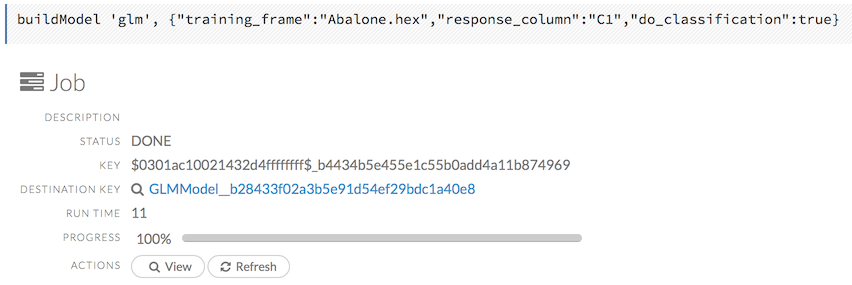
The following information displays:
- Type (for example,
Frame) - Link to object (key)
- Description (for example,
Parse) - Status
- Run time
- Progress
Note: For a better understanding of how jobs work, make sure to review the Viewing Frames section as well.
Ok, now that you understand how to find jobs in H2O, let’s submit a new one by building a model.
Models¶
Building Models¶
There are several ways to build a model, you can:
- Click the Assist Me! button in the row of buttons below the menus and select buildModel
- Click the Assist Me! button, select getFrames, then click the Build Model... button below the parsed .hex data set
- Click the View button after parsing data, then click the Build Model button
- Click the drop-down Model menu and select the model type from the list
The Build Model... button can be accessed from any page containing
the .hex key for the parsed data (for example, getJobs >
getFrame). The following image depicts the K-Means model type.
Available options vary depending on model type.
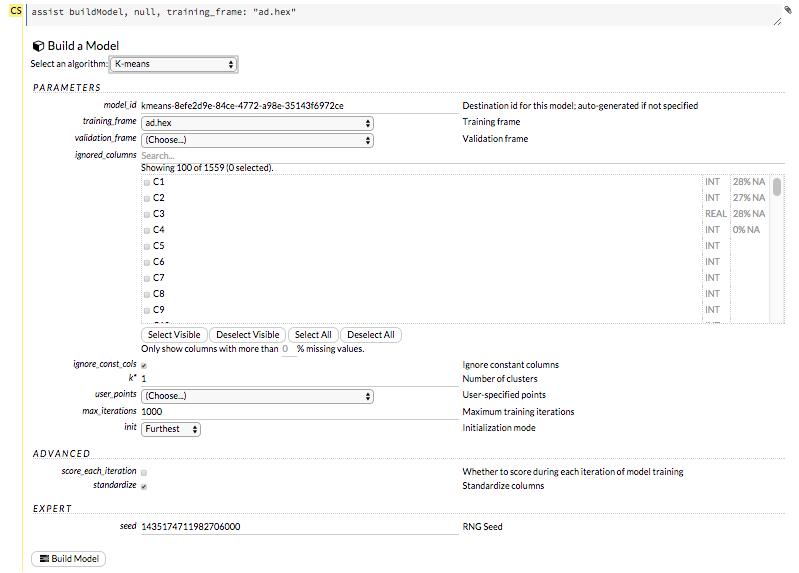
In the Build a Model cell, select an algorithm from the drop-down menu. (Refer to the Data Science Algorithms section for information about the available algorithms.)
- K-means: Create a K-Means model.
- Generalized Linear Model: Create a Generalized Linear model.
- Distributed RF: Create a distributed Random Forest model.
- Naïve Bayes: Create a Naïve Bayes model.
- Principal Component Analysis: Create a Principal Components Analysis model for modeling without regularization or performing dimensionality reduction.
- Gradient Boosting Machine: Create a Gradient Boosted model
- Deep Learning: Create a Deep Learning model.
The available options vary depending on the selected model. If an option is only available for a specific model type, the model type is listed. If no model type is specified, the option is applicable to all model types.
model_id: (Optional) Enter a custom name for the model to use as a reference. By default, H2O automatically generates an ID containing the model type (for example,
gbm-6f6bdc8b-ccbc-474a-b590-4579eea44596).training_frame: (Required) Select the dataset used to build the model.
validation_frame: (Optional) Select the dataset used to evaluate the accuracy of the model.
nfolds: (GLM, GBM, DL, DRF) Specify the number of folds for cross-validation.
response_column: (Required for GLM, GBM, DL, DRF, Naïve Bayes) Select the column to use as the independent variable.
ignored_columns: (Optional) Click the checkbox next to a column name to add it to the list of columns excluded from the model. To add all columns, click the All button. To remove a column from the list of ignored columns, click the X next to the column name. To remove all columns from the list of ignored columns, click the None button. To search for a specific column, type the column name in the Search field above the column list. To only show columns with a specific percentage of missing values, specify the percentage in the Only show columns with more than 0% missing values field. To change the selections for the hidden columns, use the Select Visible or Deselect Visible buttons.
ignore_const_cols: (Optional) Check this checkbox to ignore constant training columns, since no information can be gained from them. This option is selected by default.
transform: (PCA) Select the transformation method for the training data: None, Standardize, Normalize, Demean, or Descale.
pca_method: (PCA) Select the algorithm to use for computing the principal components:
- GramSVD: Uses a distributed computation of the Gram matrix, followed by a local SVD using the JAMA package
- Power: Computes the SVD using the power iteration method
- Randomized: Uses randomized subspace iteration method
- GLRM: Fits a generalized low-rank model with L2 loss function and no regularization and solves for the SVD using local matrix algebra
family: (GLM) Select the model type (Gaussian, Binomial, Multinomial, Poisson, Gamma, or Tweedie).
solver: (GLM) Select the solver to use (AUTO, IRLSM, L_BFGS, COORDINATE_DESCENT_NAIVE, or COORDINATE_DESCENT). IRLSM is fast on on problems with a small number of predictors and for lambda-search with L1 penalty, while L_BFGS scales better for datasets with many columns. COORDINATE_DESCENT is IRLSM with the covariance updates version of cyclical coordinate descent in the innermost loop. COORDINATE_DESCENT_NAIVE is IRLSM with the naive updates version of cyclical coordinate descent in the innermost loop. COORDINATE_DESCENT_NAIVE and COORDINATE_DESCENT are currently experimental.
link: (GLM) Select a link function (Identity, Family_Default, Logit, Log, Inverse, or Tweedie).
alpha: (GLM) Specify the regularization distribution between L2 and L2.
lambda: (GLM) Specify the regularization strength.
lambda_search: (GLM) Check this checkbox to enable lambda search, starting with lambda max. The given lambda is then interpreted as lambda min.
non-negative: (GLM) To force coefficients to be non-negative, check this checkbox.
standardize: (K-Means, GLM) To standardize the numeric columns to have mean of zero and unit variance, check this checkbox. Standardization is highly recommended; if you do not use standardization, the results can include components that are dominated by variables that appear to have larger variances relative to other attributes as a matter of scale, rather than true contribution. This option is selected by default.
beta_constraints: (GLM) To use beta constraints, select a dataset from the drop-down menu. The selected frame is used to constraint the coefficient vector to provide upper and lower bounds.
ntrees: (GBM, DRF) Specify the number of trees.
max_depth: (GBM, DRF) Specify the maximum tree depth.
min_rows: (GBM, DRF) Specify the minimum number of observations for a leaf (“nodesize” in R).
nbins: (GBM, DRF) (Numerical [real/int] only) Specify the minimum number of bins for the histogram to build, then split at the best point.
nbins_cats: (GBM, DRF) (Categorical [factors/enums] only) Specify the maximum number of bins for the histogram to build, then split at the best point. Higher values can lead to more overfitting. The levels are ordered alphabetically; if there are more levels than bins, adjacent levels share bins. This value has a more significant impact on model fitness than nbins. Larger values may increase runtime, especially for deep trees and large clusters, so tuning may be required to find the optimal value for your configuration.
learn_rate: (GBM) Specify the learning rate. The range is 0.0 to 1.0.
distribution: (GBM, DL) Select the distribution type from the drop-down list. The options are auto, bernoulli, multinomial, gaussian, poisson, gamma, or tweedie.
sample_rate: (GBM, DRF) Specify the row sampling rate (x-axis). The range is 0.0 to 1.0. Higher values may improve training accuracy. Test accuracy improves when either columns or rows are sampled. For details, refer to “Stochastic Gradient Boosting” (Friedman, 1999).
col_sample_rate: (GBM, DRF) Specify the column sampling rate (y-axis). The range is 0.0 to 1.0. Higher values may improve training accuracy. Test accuracy improves when either columns or rows are sampled. For details, refer to “Stochastic Gradient Boosting” (Friedman, 1999).
mtries: (DRF) Specify the columns to randomly select at each level. If the default value of
-1is used, the number of variables is the square root of the number of columns for classification and p/3 for regression (where p is the number of predictors).binomial_double_trees: (DRF) (Binary classification only) Build twice as many trees (one per class). Enabling this option can lead to higher accuracy, while disabling can result in faster model building. This option is disabled by default.
score_each_iteration: (K-Means, DRF, Naïve Bayes, PCA, GBM, GLM) To score during each iteration of the model training, check this checkbox.
k*: (K-Means, PCA) For K-Means, specify the number of clusters. For PCA, specify the rank of matrix approximation.
estimate_k: (K-Means) Specify whether to estimate the number of clusters (<=k) iteratively (independent of the seed) and deterministically (beginning with
k=1,2,3...). If enabled, for each k that, the estimate will go up to max_iteration. This option is disabled by default.user_points: (K-Means) For K-Means, specify the number of initial cluster centers.
max_iterations: (K-Means, PCA, GLM) Specify the number of training iterations.
init: (K-Means) Select the initialization mode. The options are Furthest, PlusPlus, Random, or User.
Note: If PlusPlus is selected, the initial Y matrix is chosen by the final cluster centers from the K-Means PlusPlus algorithm.
tweedie_variance_power: (GLM) (Only applicable if Tweedie is selected for Family) Specify the Tweedie variance power.
tweedie_link_power: (GLM) (Only applicable if Tweedie is selected for Family) Specify the Tweedie link power.
activation: (DL) Select the activation function (Tanh, TanhWithDropout, Rectifier, RectifierWithDropout, Maxout, MaxoutWithDropout). The default option is Rectifier.
hidden: (DL) Specify the hidden layer sizes (e.g., 100,100). For Grid Search, use comma-separated values: (10,10),(20,20,20). The default value is [200,200]. The specified value(s) must be positive.
epochs: (DL) Specify the number of times to iterate (stream) the dataset. The value can be a fraction.
variable_importances: (DL) Check this checkbox to compute variable importance. This option is not selected by default.
laplace: (Naïve Bayes) Specify the Laplace smoothing parameter.
min_sdev: (Naïve Bayes) Specify the minimum standard deviation to use for observations without enough data.
eps_sdev: (Naïve Bayes) Specify the threshold for standard deviation. If this threshold is not met, the min_sdev value is used.
min_prob: (Naïve Bayes) Specify the minimum probability to use for observations without enough data.
eps_prob: (Naïve Bayes) Specify the threshold for standard deviation. If this threshold is not met, the min_sdev value is used.
compute_metrics: (Naïve Bayes, PCA) To compute metrics on training data, check this checkbox. The Naïve Bayes classifier assumes independence between predictor variables conditional on the response, and a Gaussian distribution of numeric predictors with mean and standard deviation computed from the training dataset. When building a Naïve Bayes classifier, every row in the training dataset that contains at least one NA will be skipped completely. If the test dataset has missing values, then those predictors are omitted in the probability calculation during prediction.
Advanced Options
fold_assignment: (GLM, GBM, DL, DRF, K-Means) (Applicable only if a value for nfolds is specified and fold_column is not selected) Select the cross-validation fold assignment scheme. The available options are Random or Modulo.
fold_column: (GLM, GBM, DL, DRF, K-Means) Select the column that contains the cross-validation fold index assignment per observation.
offset_column: (GLM, DRF, GBM, DL) Select a column to use as the offset. Note: Offsets are per-row “bias values” that are used during model training. For Gaussian distributions, they can be seen as simple corrections to the response (y) column. Instead of learning to predict the response (y-row), the model learns to predict the (row) offset of the response column. For other distributions, the offset corrections are applied in the linearized space before applying the inverse link function to get the actual response values. For more information, refer to the following link.
weights_column: (GLM, DL, DRF, GBM) Select a column to use for the observation weights. The specified
weights_columnmust be included in the specifiedtraining_frame. Python only: To use a weights column when passing an H2OFrame toxinstead of a list of column names, the specifiedtraining_framemust contain the specifiedweights_column. Note: Weights are per-row observation weights and do not increase the size of the data frame. This is typically the number of times a row is repeated, but non-integer values are supported as well. During training, rows with higher weights matter more, due to the larger loss function pre-factor.loss: (DL) Select the loss function. For DL, the options are Automatic, Quadratic, CrossEntropy, Huber, or Absolute and the default value is Automatic. Absolute, Quadratic, and Huber are applicable for regression or classification, while CrossEntropy is only applicable for classification. Huber can improve for regression problems with outliers.
checkpoint: (DL, DRF, GBM) Enter a model key associated with a previously-trained model. Use this option to build a new model as a continuation of a previously-generated model.
use_all_factor_levels: (DL, PCA) Check this checkbox to use all factor levels in the possible set of predictors; if you enable this option, sufficient regularization is required. By default, the first factor level is skipped. For Deep Learning models, this option is useful for determining variable importances and is automatically enabled if the autoencoder is selected.
train_samples_per_iteration: (DL) Specify the number of global training samples per MapReduce iteration. To specify one epoch, enter 0. To specify all available data (e.g., replicated training data), enter -1. To use the automatic values, enter -2.
adaptive_rate: (DL) Check this checkbox to enable the adaptive learning rate (ADADELTA). This option is selected by default. If this option is enabled, the following parameters are ignored:
rate,rate_decay,rate_annealing,momentum_start,momentum_ramp,momentum_stable, andnesterov_accelerated_gradient.input_dropout_ratio: (DL) Specify the input layer dropout ratio to improve generalization. Suggested values are 0.1 or 0.2. The range is >= 0 to <1.
l1: (DL) Specify the L1 regularization to add stability and improve generalization; sets the value of many weights to 0.
l2: (DL) Specify the L2 regularization to add stability and improve generalization; sets the value of many weights to smaller values.
balance_classes: (GBM, DL) Oversample the minority classes to balance the class distribution. This option is not selected by default and can increase the data frame size. This option is only applicable for classification. Majority classes can be undersampled to satisfy the Max_after_balance_size parameter.
Note:
balance_classesbalances over just the target, not over all classes in the training frame.max_confusion_matrix_size: (DRF, DL, Naïve Bayes, GBM, GLM) Specify the maximum size (in number of classes) for confusion matrices to be printed in the Logs.
max_hit_ratio_k: (DRF, DL, Naïve Bayes, GBM, GLM) Specify the maximum number (top K) of predictions to use for hit ratio computation. Applicable to multinomial only. To disable, enter 0.
r2_stopping: (GBM, DRF) Specify a threshold for the coefficient of determination (r^2) metric value. When this threshold is met or exceeded, H2O stops making trees.
build_tree_one_node: (DRF, GBM) To run on a single node, check this checkbox. This is suitable for small datasets as there is no network overhead but fewer CPUs are used. The default setting is disabled.
rate: (DL) Specify the learning rate. Higher rates result in less stable models and lower rates result in slower convergence. Not applicable if adaptive_rate is enabled.
rate_annealing: (DL) Specify the learning rate annealing. The formula is rate/(1+rate_annealing value * samples). Not applicable if adaptive_rate is enabled.
momentum_start: (DL) Specify the initial momentum at the beginning of training. A suggested value is 0.5. Not applicable if adaptive_rate is enabled.
momentum_ramp: (DL) Specify the number of training samples for increasing the momentum. Not applicable if adaptive_rate is enabled.
momentum_stable: (DL) Specify the final momentum value reached after the momentum_ramp training samples. Not applicable if adaptive_rate is enabled.
nesterov_accelerated_gradient: (DL) Check this checkbox to use the Nesterov accelerated gradient. This option is recommended and selected by default. Not applicable is adaptive_rate is enabled.
hidden_dropout_ratios: (DL) Specify the hidden layer dropout ratios to improve generalization. Specify one value per hidden layer, each value between 0 and 1 (exclusive). There is no default value. This option is applicable only if TanhwithDropout, RectifierwithDropout, or MaxoutWithDropout is selected from the Activation drop-down list.
tweedie_power: (DL, GBM) (Only applicable if Tweedie is selected for Family) Specify the Tweedie power. The range is from 1 to 2. For a normal distribution, enter
0. For Poisson distribution, enter1. For a gamma distribution, enter2. For a compound Poisson-gamma distribution, enter a value greater than 1 but less than 2. For more information, refer to Tweedie distribution.score_interval: (DL) Specify the shortest time interval (in seconds) to wait between model scoring.
score_training_samples: (DL) Specify the number of training set samples for scoring. To use all training samples, enter 0.
score_validation_samples: (DL) (Requires selection from the validation_frame drop-down list) This option is applicable to classification only. Specify the number of validation set samples for scoring. To use all validation set samples, enter 0.
score_duty_cycle: (DL) Specify the maximum duty cycle fraction for scoring. A lower value results in more training and a higher value results in more scoring. The value must be greater than 0 and less than 1.
autoencoder: (DL) Check this checkbox to enable the Deep Learning autoencoder. This option is not selected by default.
Note: This option requires a loss function other than CrossEntropy. If this option is enabled, use_all_factor_levels must be enabled.
Expert Options
keep_cross_validation_predictions: (GLM, GBM, DL, DRF, K-Means) To keep the cross-validation predictions, check this checkbox.
class_sampling_factors: (DRF, GBM, DL) Specify the per-class (in lexicographical order) over/under-sampling ratios. By default, these ratios are automatically computed during training to obtain the class balance. This option is only applicable for classification problems and when balance_classes is enabled.
overwrite_with_best_model: (DL) Check this checkbox to overwrite the final model with the best model found during training. This option is selected by default.
target_ratio_comm_to_comp: (DL) Specify the target ratio of communication overhead to computation. This option is only enabled for multi-node operation and if train_samples_per_iteration equals -2 (auto-tuning).
rho: (DL) Specify the adaptive learning rate time decay factor. This option is only applicable if adaptive_rate is enabled.
epsilon: (DL) Specify the adaptive learning rate time smoothing factor to avoid dividing by zero. This option is only applicable if adaptive_rate is enabled.
max_w2: (DL) Specify the constraint for the squared sum of the incoming weights per unit (e.g., for Rectifier).
initial_weight_distribution: (DL) Select the initial weight distribution (Uniform Adaptive, Uniform, or Normal). If Uniform Adaptive is used, the initial_weight_scale parameter is not applicable.
initial_weight_scale: (DL) Specify the initial weight scale of the distribution function for Uniform or Normal distributions. For Uniform, the values are drawn uniformly from initial weight scale. For Normal, the values are drawn from a Normal distribution with the standard deviation of the initial weight scale. If Uniform Adaptive is selected as the initial_weight_distribution, the initial_weight_scale parameter is not applicable.
classification_stop: (DL) (Applicable to discrete/categorical datasets only) Specify the stopping criterion for classification error fractions on training data. To disable this option, enter -1.
max_hit_ratio_k: (DL, GLM) (Classification only) Specify the maximum number (top K) of predictions to use for hit ratio computation (for multinomial only). To disable this option, enter 0.
regression_stop: (DL) (Applicable to real value/continuous datasets only) Specify the stopping criterion for regression error (MSE) on the training data. To disable this option, enter -1.
diagnostics: (DL) Check this checkbox to compute the variable importances for input features (using the Gedeon method). For large networks, selecting this option can reduce speed. This option is selected by default.
fast_mode: (DL) Check this checkbox to enable fast mode, a minor approximation in back-propagation. This option is selected by default.
force_load_balance: (DL) Check this checkbox to force extra load balancing to increase training speed for small datasets and use all cores. This option is selected by default.
single_node_mode: (DL) Check this checkbox to force H2O to run on a single node for fine-tuning of model parameters. This option is not selected by default.
replicate_training_data: (DL) Check this checkbox to replicate the entire training dataset on every node for faster training on small datasets. This option is not selected by default. This option is only applicable for clouds with more than one node.
shuffle_training_data: (DL) Check this checkbox to shuffle the training data. This option is recommended if the training data is replicated and the value of train_samples_per_iteration is close to the number of nodes times the number of rows. This option is not selected by default.
missing_values_handling: (DL, GLM) Select how to handle missing values (Skip or MeanImputation).
quiet_mode: (DL) Check this checkbox to display less output in the standard output. This option is not selected by default.
sparse: (DL) Check this checkbox to enable sparse data handling, which is more efficient for data with many zero values.
col_major: (DL) Check this checkbox to use a column major weight matrix for the input layer. This option can speed up forward propagation but may reduce the speed of backpropagation. This option is not selected by default.
Note: This parameter has been deprecated.
average_activation: (DL) Specify the average activation for the sparse autoencoder. If Rectifier is selected as the Activation type, this value must be positive. For Tanh, the value must be in (-1,1).
sparsity_beta: (DL) Specify the sparsity-based regularization optimization. For more information, refer to the following link.
max_categorical_features: (DL) Specify the maximum number of categorical features enforced via hashing.
reproducible: (DL) To force reproducibility on small data, check this checkbox. If this option is enabled, the model takes more time to generate, since it uses only one thread.
export_weights_and_biases: (DL) To export the neural network weights and biases as H2O frames, check this checkbox.
max_after_balance_size: (DRF, GBM, DL) Specify the maximum relative size of the training data after balancing class counts (can be less than 1.0). Requires balance_classes.
nbins_top_level: (DRF, GBM) (For numerical [real/int] columns only) Specify the maximum number of bins at the root level to use to build the histogram. This number will then be decreased by a factor of two per level.
seed: (K-Means, GBM, DL, DRF) Specify the random number generator (RNG) seed for algorithm components dependent on randomization. The seed is consistent for each H2O instance so that you can create models with the same starting conditions in alternative configurations.
intercept: (GLM) To include a constant term in the model, check this checkbox. This option is selected by default.
objective_epsilon: (GLM) Specify a threshold for convergence. If the objective value is less than this threshold, the model is converged.
beta_epsilon: (GLM) Specify the beta epsilon value. If the L1 normalization of the current beta change is below this threshold, consider using convergence.
gradient_epsilon: (GLM) (For L-BFGS only) Specify a threshold for convergence. If the objective value (using the L-infinity norm) is less than this threshold, the model is converged.
prior: (GLM) Specify prior probability for y ==1. Use this parameter for logistic regression if the data has been sampled and the mean of response does not reflect reality.
max_active_predictors: (GLM) Specify the maximum number of active predictors during computation. This value is used as a stopping criterium to prevent expensive model building with many predictors.
Viewing Models¶
Click the Assist Me! button, then click the getModels link, or
enter getModels in the cell in CS mode and press Ctrl+Enter. A
list of available models displays.

To view all current models, you can also click the Model menu and click List All Models.
To inspect a model, check its checkbox then click the Inspect button, or click the Inspect button to the right of the model name.
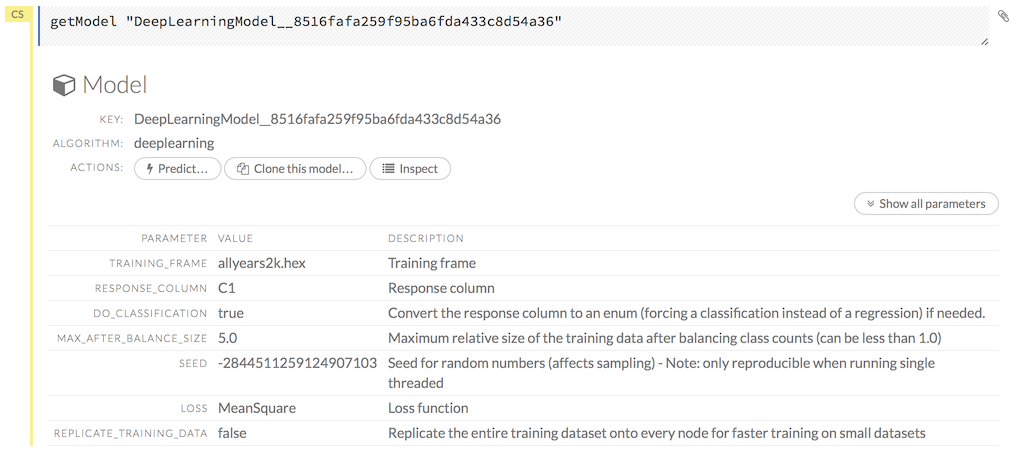
A summary of the model’s parameters displays. To display more details, click the Show All Parameters button.
To delete a model, click the Delete button.
To generate a Plain Old Java Object (POJO) that can use the model outside of H2O, click the Download POJO button.
Note: A POJO can be run in standalone mode or it can be integrated
into a platform, such as Hadoop’s
Storm.
To make the POJO work in your Java application, you will also need the
h2o-genmodel.jar file (available in
h2o-3/h2o-genmodel/build/libs/h2o-genmodel.jar).
Exporting and Importing Models¶
To export a built model:
- Click the Model menu at the top of the screen.
- Select Export Model...
- In the
exportModelcell that appears, select the model from the drop-down Model: list. - Enter a location for the exported model in the Path: entry field.
Note: If you specify a location that doesn’t exist, it will be
created. For example, if you only enter
testin the Path: entry field, the model will be exported toh2o-3/test. - To overwrite any files with the same name, check the Overwrite: checkbox.
- Click the Export button. A confirmation message displays when the model has been successfully exported.
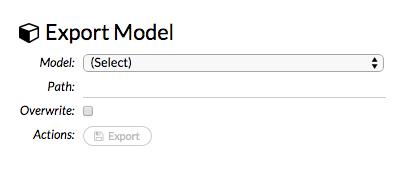
To import a built model:
- Click the Model menu at the top of the screen.
- Select Import Model...
- Enter the location of the model in the Path: entry field. Note:
The file path must be complete (e.g.,
Users/h2o-user/h2o-3/exported_models). Do not rename models while importing. - To overwrite any files with the same name, check the Overwrite: checkbox.
- Click the Import button. A confirmation message displays when the model has been successfully imported. To view the imported model, click the View Model button.
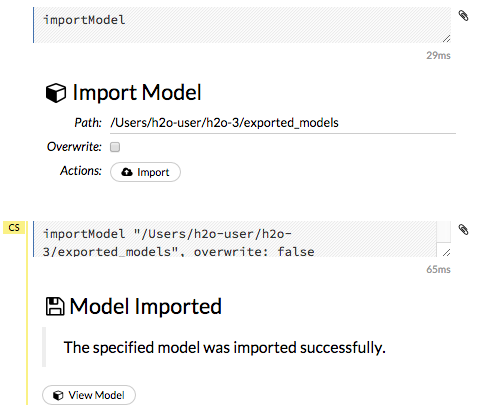
Using Grid Search¶
To include a parameter in a grid search in Flow, check the checkbox in the GRID? column to the right of the parameter name (highlighted in red in the image below).

- If the parameter selected for grid search is Boolean (T/F or Y/N), both values are included when the Grid? checkbox is selected.
- If the parameter selected for grid search is a list of values, the values display as checkboxes when the Grid? checkbox is selected. More than one option can be selected.
- If the parameter selected for grid search is a numerical value, use a semicolon (;) to separate each additional value.
- To view a list of all grid searches, select the Model menu, then click List All Grid Search Results, or click the Assist Me button and select getGrids.
Checkpointing Models¶
Some model types, such as DRF, GBM, and Deep Learning, support checkpointing. A checkpoint resumes model training so that you can iterate your model. The dataset must be the same. The following model parameters must be the same when restarting a model from a checkpoint:
| Must be the same as in checkpoint model | ||
|---|---|---|
drop_na20_cols |
response_column |
activation |
use_all_factor_levels |
adaptive_rate |
autoencoder |
rho |
epsilon |
sparse |
sparsity_beta |
col_major |
rate |
rate_annealing |
rate_decay |
momentum_start |
momentum_ramp |
momentum_stable |
nesterov_accelerated_gradient |
ignore_const_cols |
max_categorical_features |
nfolds |
distribution |
tweedie_power |
The following parameters can be modified when restarting a model from a checkpoint:
| Can be modified | ||
|---|---|---|
seed |
checkpoint |
epochs |
score_interval |
train_samples_per_iteration |
target_ratio_comm_to_comp |
score_duty_cycle |
score_training_samples |
score_validation_samples |
score_validation_sampling |
classification_stop |
regression_stop |
quiet_mode |
max_confusion_matrix_size |
max_hit_ratio_k |
diagnostics |
variable_importances |
initial_weight_distribution |
initial_weight_scale |
force_load_balance |
replicate_training_data |
shuffle_training_data |
single_node_mode |
fast_mode |
l1 |
l2 |
max_w2 |
input_dropout_ratio |
hidden_dropout_ratios |
loss |
overwrite_with_best_model |
missing_values_handling |
average_activation |
reproducible |
export_weights_and_biases |
elastic_averaging |
elastic_averaging_moving_rate |
elastic_averaging_regularization |
mini_batch_size |
- After building your model, copy the
model_id. To view themodel_id, click the Model menu then click List All Models. - Select the model type from the drop-down Model menu. Note: The model type must be the same as the checkpointed model.
- Paste the copied
model_idin the checkpoint entry field. - Click the Build Model button. The model will resume training.
Interpreting Model Results¶
Scoring history: (GBM, DL) Represents the error rate of the model as it is built. Typically, the error rate will be higher at the beginning (the left side of the graph) then decrease as the model building completes and accuracy improves. Can include mean squared error (MSE) and deviance.

Variable importances: (GBM, DL) Represents the statistical significance of each variable in the data in terms of its affect on the model. Variables are listed in order of most to least importance. The percentage values represent the percentage of importance across all variables, scaled to 100%. The method of computing each variable’s importance depends on the algorithm. To view the scaled importance value of a variable, use your mouse to hover over the bar representing the variable.
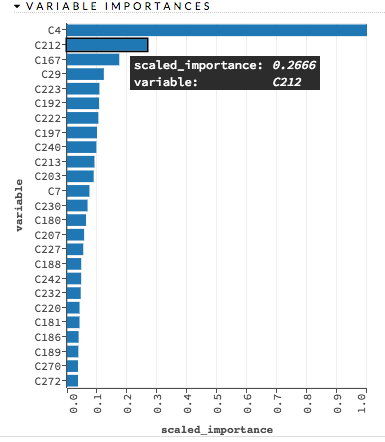
Confusion Matrix: (DL) Table depicting performance of
algorithm in terms of false positives, false negatives, true positives,
and true negatives. The actual results display in the columns and the
predictions display in the rows; correct predictions are highlighted in
yellow. In the example below, 0 was predicted correctly 902 times,
while 8 was predicted correctly 822 times and 0 was predicted as
4 once.
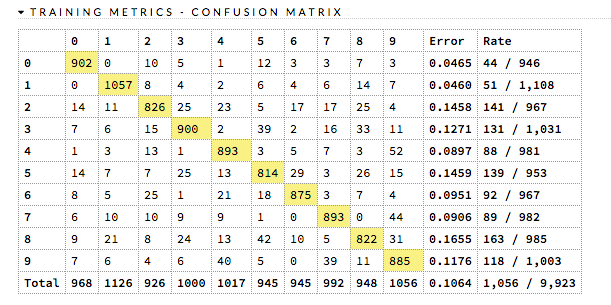
ROC Curve: (DL, GLM, DRF) Graph representing the ratio of true positives to false positives. To view a specific threshold, select a value from the drop-down Threshold list. To view any of the following details, select it from the drop-down Criterion list:
- Max f1
- Max f2
- Max f0point5
- Max accuracy
- Max precision
- Max absolute MCC (the threshold that maximizes the absolute Matthew’s Correlation Coefficient)
- Max min per class accuracy
The lower-left side of the graph represents less tolerance for false positives while the upper-right represents more tolerance for false positives. Ideally, a highly accurate ROC resembles the following example.

Hit Ratio: (GBM, DRF, NaiveBayes, DL, GLM) (Multinomial Classification only) Table representing the number of times that the prediction was correct out of the total number of predictions.
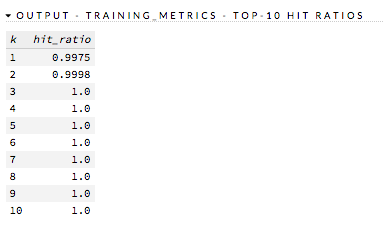
Standardized Coefficient Magnitudes (GLM) Bar chart representing the relationship of a specific feature to the response variable. Coefficients can be positive (orange) or negative (blue). A positive coefficient indicates a positive relationship between the feature and the response, where an increase in the feature corresponds with an increase in the response, while a negative coefficient represents a negative relationship between the feature and the response where an increase in the feature corresponds with a decrease in the response (or vice versa).

Partial Dependence Plots¶
For models that include only numerical values, you can view a Partial Dependence Plot (PDP) for that model. This provides a graphical representation of the marginal effect of a variable on the class probability (classification) or response (regression).
Note: The outputted PDPs include the top 10 most important features in a model.
Viewing Partial Dependence Plots¶
- To view a PDP for a model, click the Score dropdown at the top of the Flow UI, then select Partial Dependence Plots.
- Specify the Model and Frame that you want to use to retrieve the plots, and specify the number of bins (levels that PDP will compute). Note that more levels will result in slower speeds. Click Compute when you are done.
Note: Be sure to specify the dataframe that was used to build the selected model.

- After the job is finished, click View to see the plots.
Predictions¶
After creating your model, click the key link for the model, then click the Predict button. Select the model to use in the prediction from the drop-down Model: menu and the data frame to use in the prediction from the drop-down Frame: menu, then click the Predict button.

Viewing Predictions¶
Click the Assist Me! button, then click the getPredictions link,
or enter getPredictions in the cell in CS mode and press
Ctrl+Enter. A list of the stored predictions displays. To view a
prediction, click the View button to the right of the model name.

You can also view predictions by clicking the drop-down Score menu and selecting List All Predictions.
Intepreting the Gains/Lift Chart¶
The Gains/Lift chart evaluates the prediction ability of a binary classification model. The chart is computed using the prediction probability and the true response (class) labels. The accuracy of the classification model for a random sample is evaluated according to the results when the model is and is not used.
This information is particularly useful for direct marketing applications, for example. The gains/lift chart shows the effectiveness of the current model(s) compared to a baseline, allowing users to quickly identify the most useful model.
By default, H2O reports the Gains/Lift for all binary classification models if the following requirements are met:
- The training frame dataset must contain actual binary class labels.
- The prediction column used as the response must contain probabilities.
- For GLM, the visualization displays only when using
nfolds(for example,nfolds=2). - The model type cannot be K-means or PCA.
How the Gains/Lift Chart is Built¶
To compute Gains/Lift, H2O applies the model to the original dataset to find the response probability. The data is divided into groups by quantile thresholds of the response probability. Note that the default number of groups is 20; if there are fewer than 20 unique probability values, then the number of groups is reduced to the number of unique quantile thresholds. For binning, H2O computes exact ventiles. (Weighted cases are in development.) h2o.quantile(x, probs=seq(0,1,0.05)) is used for cut points, similar to R’s quantile() method.
For each group, the lift is calculated as the proportion of observations that are events (targets) in the group to the overall proportion of events (targets).
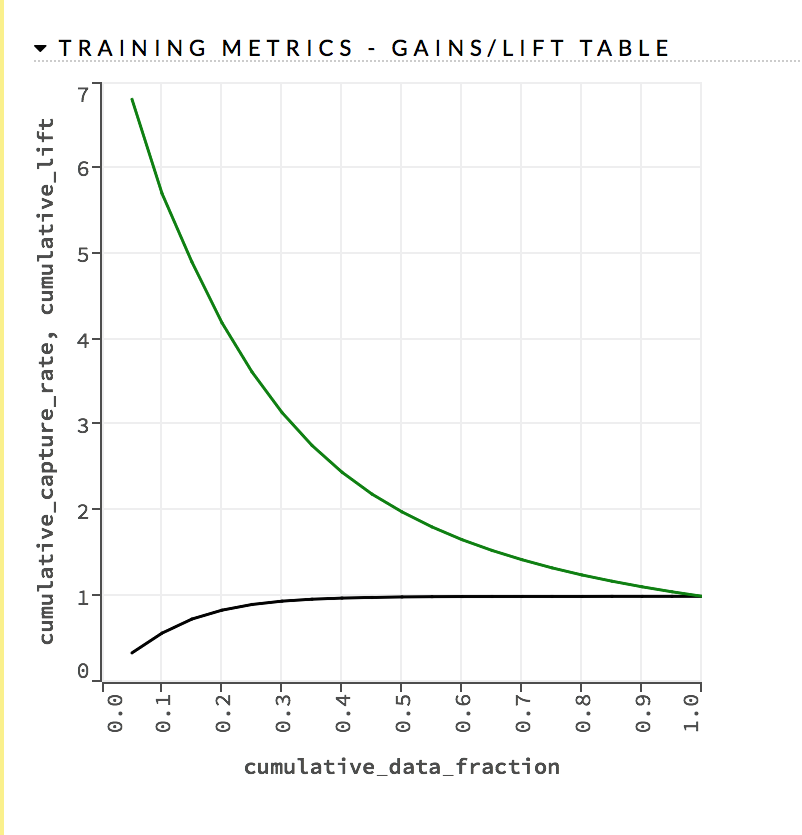
Note: During the Gains/Lift calculations, all rows containing missing values (“NAs”) in either the label (response) or the prediction probability are ignored.
In addition to the chart, a Gains/Lift table is also available. This table reports the following for each group:
- Threshold probability value
- Cumulative data fractions
- Response rates (proportion of observations that are events in a group)
- Cumulative response rate
- Event capture rate
- Cumulative capture rate
- Gain (difference in percentages between the overall proportion of events and the observed proportion of observations that are events in the group)
- Cumulative gain
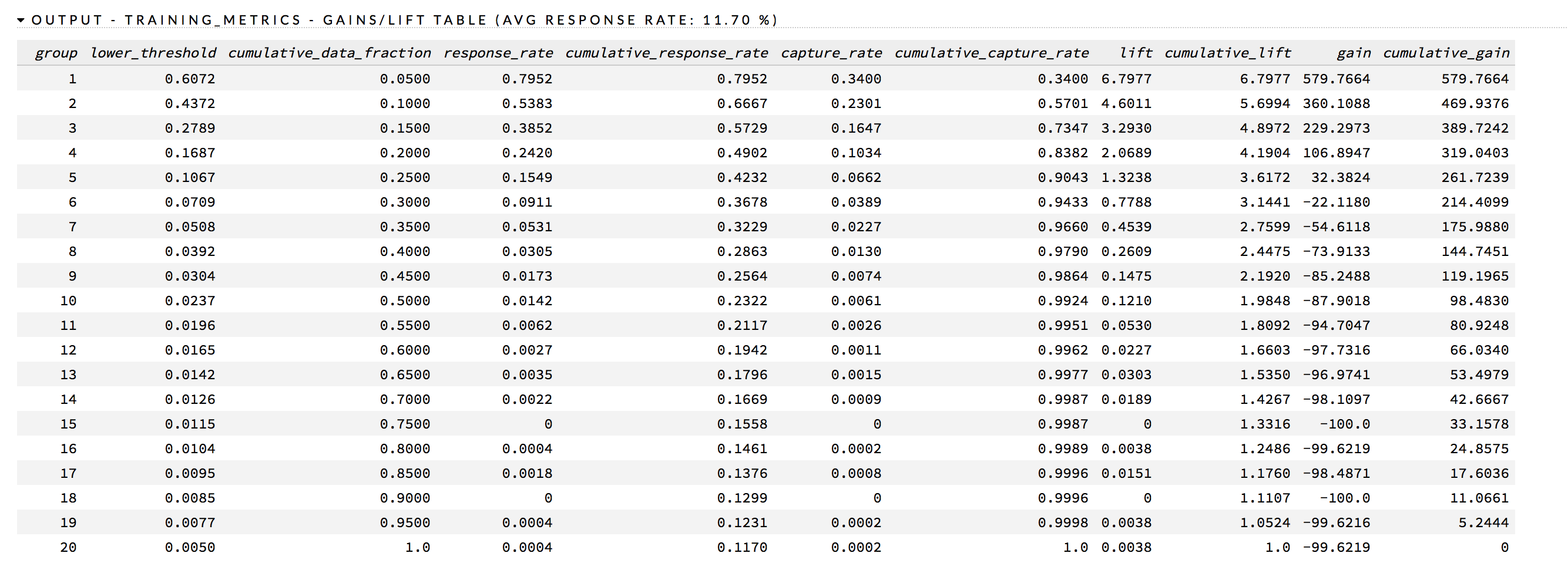
The response_rate column lists the likelihood of response, the lift column lists the lift rate, and the cumulative_lift column provides the percentage of increase in response based on the lift.
Frames¶
An H2O frame represents a 2D array of data. The data may be local or it may be distributed in an H2O cluster.
Creating Frames¶
To create a frame with a large amount of random data (for example, to use for testing), click the drop-down Admin menu, then select Create Synthetic Frame. Customize the frame as needed, then click the Create button to create the frame.
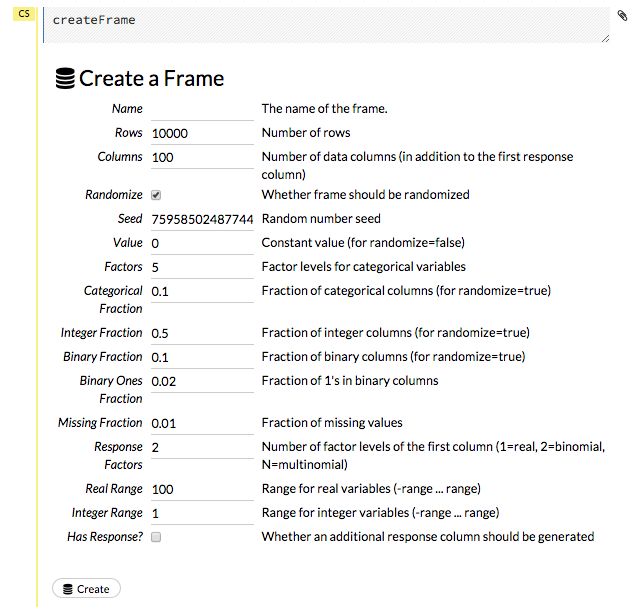
Viewing Frames¶
To view a specific frame, click the “Key” link for the specified frame,
or enter getFrameSummary "FrameName" in a cell in CS mode (where
FrameName is the name of a frame, such as allyears2k.hex).
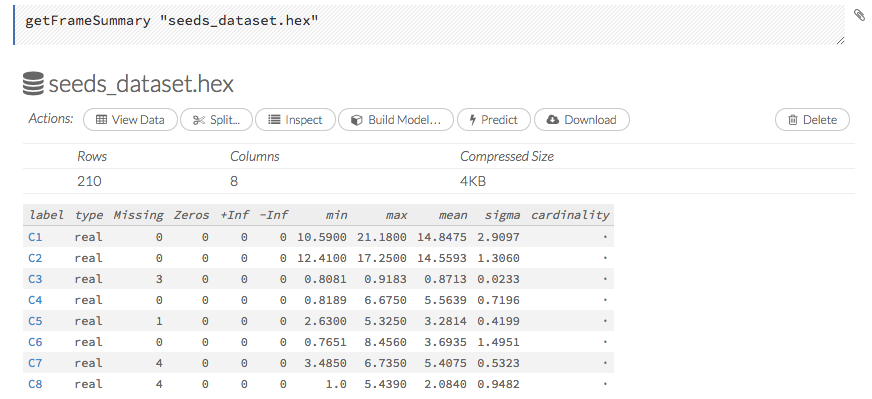
From the getFrameSummary cell, you can:
- View a truncated list of the rows in the data frame by clicking the View Data button
- Split the dataset by clicking the Split... button
- View the columns, data, and factors in more detail or plot a graph by clicking the Inspect button
- Create a model by clicking the Build Model button
- Make a prediction based on the data by clicking the Predict button
- Download the data as a .csv file by clicking the Download button
- View the characteristics or domain of a specific column by clicking the Summary link
When you view a frame, you can “drill-down” to the necessary level of detail (such as a specific column or row) using the Inspect button or by clicking the links. The following screenshot displays the results of clicking the Inspect button for a frame.
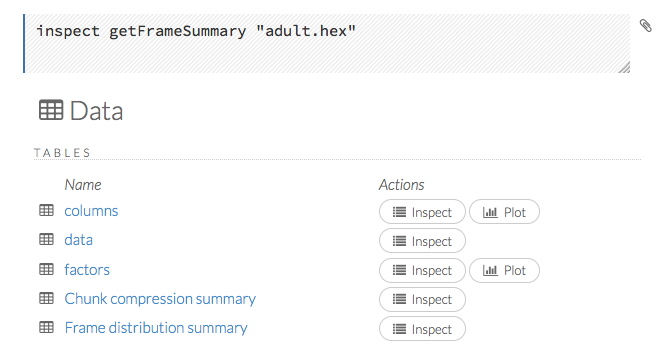
This screenshot displays the results of clicking the columns link.
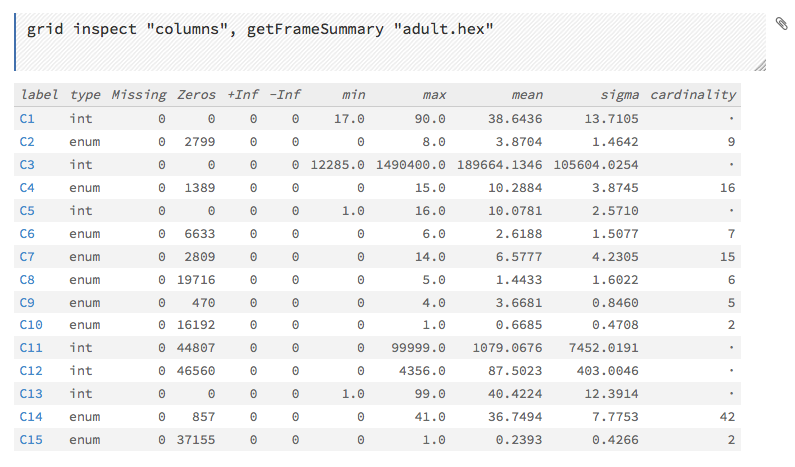
To view all frames, click the Assist Me! button, then click the
getFrames link, or enter getFrames in the cell in CS mode and
press Ctrl+Enter. You can also view all current frames by clicking
the drop-down Data menu and selecting List All Frames.
A list of the current frames in H2O displays that includes the following information for each frame:
- Link to the frame (the “key”)
- Number of rows and columns
- Size
For parsed data, the following information displays:
- Link to the .hex file
- The Build Model, Predict, and Inspect buttons
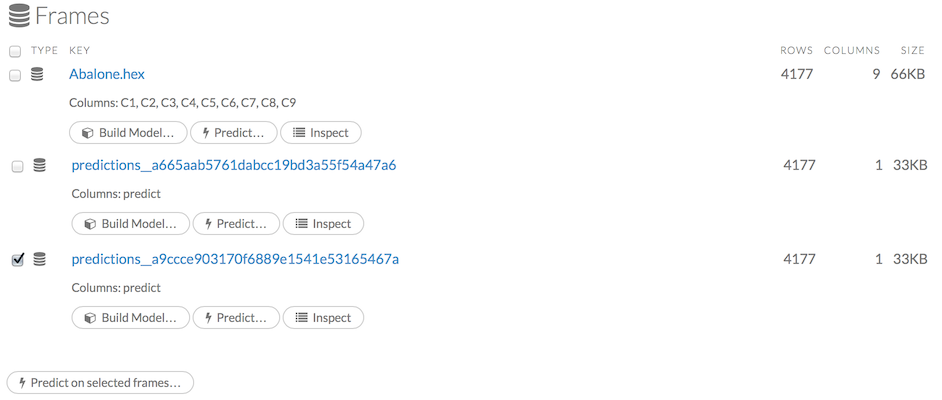
To make a prediction, check the checkboxes for the frames you want to use to make the prediction, then click the Predict on Selected Frames button.
Splitting Frames¶
Datasets can be split within Flow for use in model training and testing.
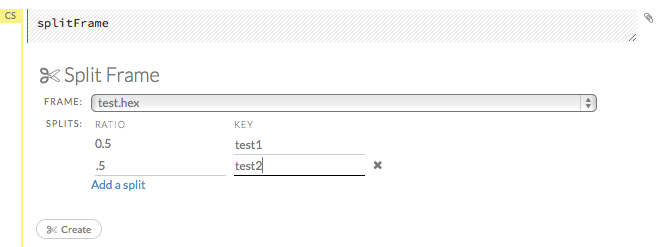
- To split a frame, click the Assist Me button, then click splitFrame.
Note: You can also click the drop-down Data menu and select Split Frame....
- From the drop-down Frame: list, select the frame to split.
- In the second Ratio entry field, specify the fractional value to determine the split. The first Ratio field is automatically calculated based on the values entered in the second Ratio field.
Note: Only fractional values between 0 and 1 are supported (for example, enter.5to split the frame in half). The total sum of the ratio values must equal one. H2O automatically adjusts the ratio values to equal one; if unsupported values are entered, an error displays.
- In the Key entry field, specify a name for the new frame.
- (Optional) To add another split, click the Add a split link. To remove a split, click the
Xto the right of the Key entry field. - Click the Create button.
Plotting Frames¶
To create a plot from a frame, click the Inspect button, then click the Plot button for columns or factors. Note that from this section, you can also inspect the Chunk compression summary and the Frame distribution summary.
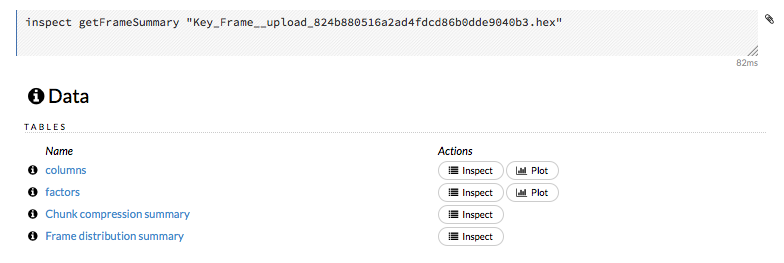
Select the type of plot from the Type menu
- plot: Creates a graph with a series of plot points.
- path: Creates a line graph connecting plot points.
- rect: Creates a bar graph. Note that with rect graphs, you cannot specify values of the same type. You will receive an error if you attempt to specify, for example, two String columns or two Number columns.
Specify the information that you want to view on the X axis and on the Y axis. Select from the following options below. These options correspond to the parsed data file.
- label: Plots the column headings
- type: Plots real vs. enum values
- Missing: Plots missing values
- Zeros: Plots
0values - +Inf: Plots positiive
infvalues - -Inf: Plots negative
infvalues - min: Plots the min value
- max: Plots the max value
- mean: Plots the mean value
- sigma: Plots the sigma value
- cardinality: Plots the cardinality. Used with enum values.
- Actions: Plots actions (for example, “convert to numeric”.)
Select one of the above options from the drop-down Color menu to display the specified data in color.
click the Plot button to plot the data.
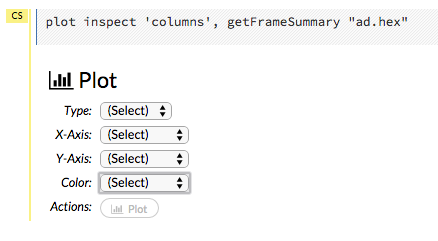
Note: Because H2O stores enums internally as numeric then maps the
integers to an array of strings, any min, max, or mean
values for categorical columns are not meaningful and should be ignored.
Displays for categorical data will be modified in a future version of
H2O.
Troubleshooting Flow¶
To troubleshoot issues in Flow, use the Admin menu. The Admin menu allows you to check the status of the cluster, view a timeline of events, and view or download logs for issue analysis.
Note: To view the current H2O Flow version, click the Help menu, then click About.
Viewing Cluster Status¶
Click the Admin menu, then select Cluster Status. A summary of the status of the cluster (also known as a cloud) displays, which includes the same information:
- Cluster health
- Whether all nodes can communicate (consensus)
- Whether new nodes can join (locked/unlocked)
Note: After you submit a job to H2O, the cluster does not accept new nodes. - H2O version - Number of used and available nodes - When the cluster was created
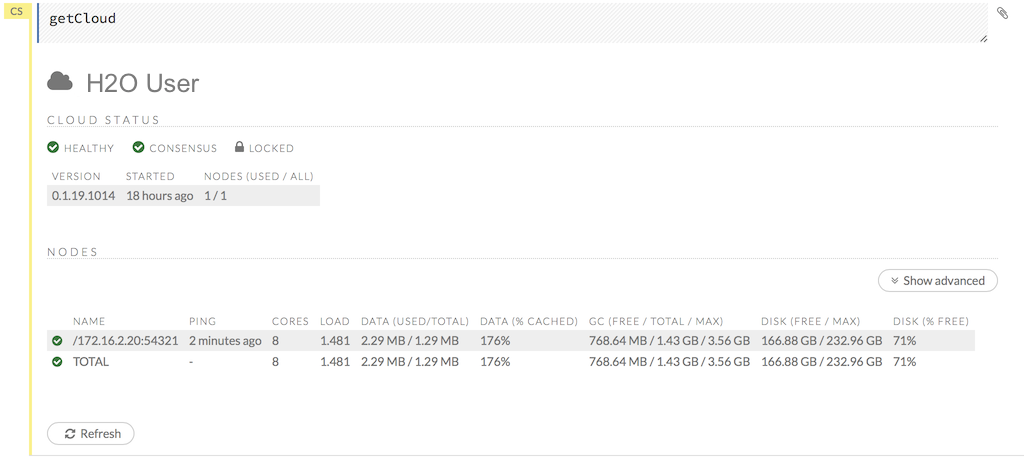
The following information displays for each node:
- IP address (name)
- Time of last ping
- Number of cores
- Load
- Amount of data (used/total)
- Percentage of cached data
- GC (free/total/max)
- Amount of disk space in GB (free/max)
- Percentage of free disk space
To view more information, click the Show Advanced button.
Viewing CPU Status (Water Meter)¶
To view the current CPU usage, click the Admin menu, then click Water Meter (CPU Meter). A new window opens, displaying the current CPU use statistics.
Viewing Logs¶
To view the logs for troubleshooting, click the Admin menu, then click Inspect Log.

To view the logs for a specific node, select it from the drop-down Select Node menu.
Downloading Logs¶
To download the logs for further analysis, click the Admin menu, then click Download Log. A new window opens and the logs download to your default download folder. You can close the new window after downloading the logs. Send the logs to h2ostream or file a JIRA ticket for issue resolution. (Refer to Reporting Issues.)
Viewing Stack Trace Information¶
To view the stack trace information, click the Admin menu, then click Stack Trace.
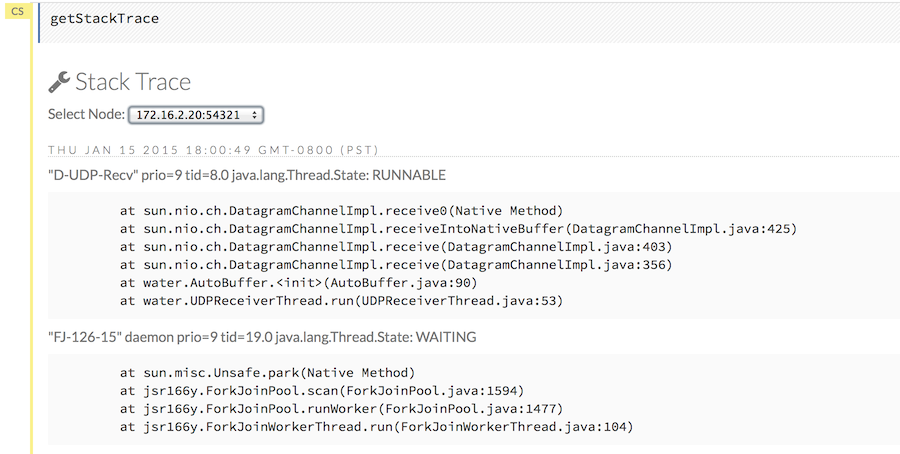
To view the stack trace information for a specific node, select it from the drop-down Select Node menu.
Viewing Network Test Results¶
To view network test results, click the Admin menu, then click Network Test.

Accessing the Profiler¶
The Profiler looks across the cluster to see where the same stack trace occurs, and can be helpful for identifying activity on the current CPU. To view the profiler, click the Admin menu, then click Profiler.

To view the profiler information for a specific node, select it from the drop-down Select Node menu.
Viewing the Timeline¶
To view a timeline of events in Flow, click the Admin menu, then click Timeline. The following information displays for each event:
- Time of occurrence (HH:MM:SS:MS)
- Number of nanoseconds for duration
- Originator of event (“who”)
- I/O type
- Event type
- Number of bytes sent & received

To obtain the most recent information, click the Refresh button.
Reporting Issues¶
If you experience an error with Flow, you can submit a JIRA ticket to notify our team.
- First, click the Admin menu, then click Download Logs. This will download a file contains information that will help our developers identify the cause of the issue.
- Click the Help menu, then click Report an issue. This will open our JIRA page where you can file your ticket.
- Click the Create button at the top of the JIRA page.
- Attach the log file from the first step, write a description of the error you experienced, then click the Create button at the bottom of the page. Our team will work to resolve the issue and you can track the progress of your ticket in JIRA.
Requesting Help¶
If you have a Google account, you can submit a request for assistance with H2O on our Google Groups page, H2Ostream.
To access H2Ostream from Flow:
- Click the Help menu.
- Click Forum/Ask a question.
- Click the red New topic button.
- Enter your question and click the red Post button. If you are requesting assistance for an error you experienced, be sure to include your logs. (Refer to Downloading Logs.)
You can also email your question to h2ostream@googlegroups.com.
Shutting Down H2O¶
To shut down H2O, click the Admin menu, then click Shut Down. A Shut down complete message displays in the upper right when the cluster has been shut down.

